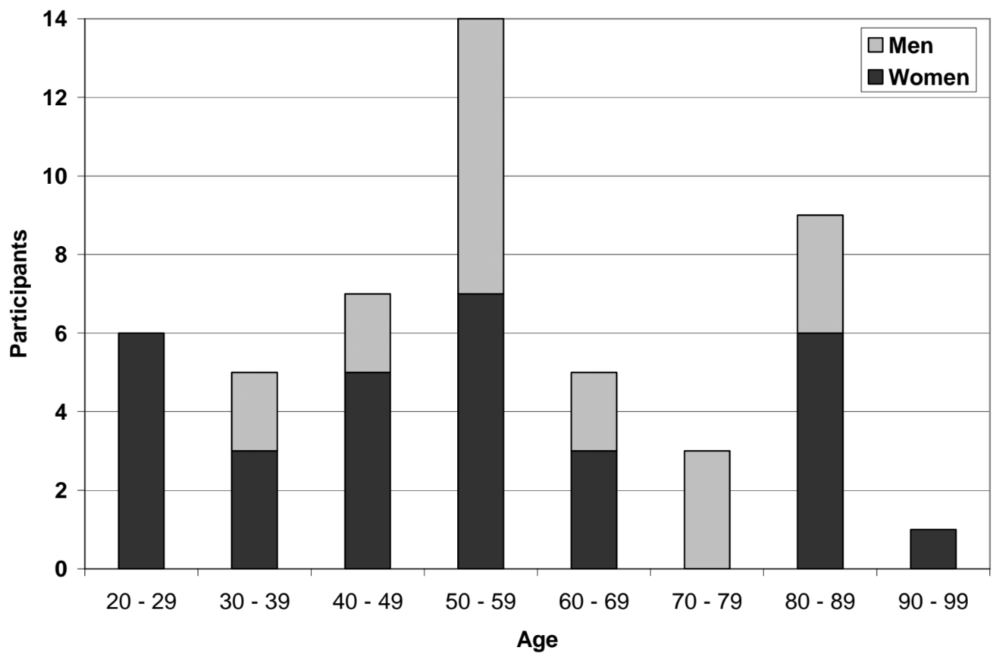Visual Detection of Detectable Warning Materials by Pedestrians with Visual Impairments - Final Report
1.4 Participants
Fifty adults with low vision were recruited through contacts with local organizations for people who are blind or visually impaired. Information about the study was also distributed through email lists, flyers in medical offices and retirement communities, and through personal contacts of orientation and mobility specialists in the Washington, DC, area. Some participants were referred by other participants. Individuals were invited to participate based on their responses to a screener questionnaire. When people called to inquire about the study they were asked about the nature and severity of their visual impairments, their frequency of travel and difficulties experienced while walking, and the travel aids they use. Self-reported difficulty in detecting streets and curb ramps was a major criterion used to select participants for the study. Participants were compensated with $75 for their time and were reimbursed for local travel expenses.
Participants ranged in age from 24 to 92 years old, with a median age of 54. The distribution of participants’ ages by gender is shown in Figure 1. There were 31 women and 19 men in the sample. Each age group contained both men and women except for the youngest age group (20 – 29 years) and oldest age group (90-99) which each consisted of women only and the 70-79 years-old group which consisted of men only.
Participants ranged in age from 24 to 92 years old, with a median age of 54. The distribution of participants’ ages by gender is shown in Figure 1. There were 31 women and 19 men in the sample. Each age group contained both men and women except for the youngest age group (20 to 29) and oldest age group (90 to 99) which each consisted of women only and the 70 to 79 years-old group which consisted of men only. The most frequently reported travel aid was a long cane, which was used by 36 participants. Some participants reported that they use more than one kind of travel aid, choosing what they need based on the duration of the planned trip, their familiarity with the area where they will be traveling, and the anticipated lighting conditions. The use of travel aids during the study was permitted. Mobility aids such as support canes and walkers were also allowed. Eyeglasses and sunglasses were allowed, though viewing scopes such as monoculars were not allowed.
Nearly all of the selected participants were legally blind as a result of limited visual acuity, limited field of vision, or a combination of the two, but all participants had some useful vision (more than light perception). None of the participants had a driver’s license and all reported walking on sidewalks occasionally or frequently, either with or without travel aids. The number of participants who reported using travel aids at least occasionally is shown in Table 1. The most frequently re ported travel aid was a long cane, which was used by 36 participants. Some participants reported that they use more than one kind of travel aid, choosing what they need based on the duration of the planned trip, their familiarity with the area where they will be traveling and the anticipated lighting conditions. The use of travel aids during the study was permitted. Mobility aids such as support canes and walkers were also allowed. Eyeglasses and sunglasses were allowed, though viewing scopes such as monoculars were not allowed.
Figure 1. Chart. Distribution of Participants’ Ages by Gender
| Travel Aid |
Participants Reporting Use |
|---|---|
| Long cane | 36 |
| Dog guide | 4 |
| Monocular/ telescope/ magnifying glasses | 3 |
| Short cane / support cane | 6 |
| Walker | 2 |
| Wheel chair | 1 |
| No travel aids used | 10 |
Participants’ visual impairments were diverse and in several cases vision was affected by multiple medical conditions. The complete list of participants’ self-reported conditions affecting their vision is given below in Table 2. The most commonly reported conditions were glaucoma, cataract, and macular degeneration.
| Medical Condition | Participants Reporting Condition |
|---|---|
| Glaucoma | 13 |
| Cataract | 12 |
| Macular degeneration/ macular dystrophy | 10 |
| Retinitis pigmentosa | 6 |
| Optic neuritis / optic nerve atrophy | 6 |
| Brain injury | 5 |
| Diabetic retinopathy | 5 |
| Retinopathy of prematurity | 4 |
| Retinal detachment | 3 |
| Albinism | 2 |
| Corneal dystrophy/ other corneal disease | 2 |
| Myopic degeneration | 1 |
| Inverse retinitis pigmentosa | 1 |
| Uveitis | 1 |
| Stargardt's disease | 1 |
| Giant cell arthritis | 1 |


User Comments/Questions
Add Comment/Question